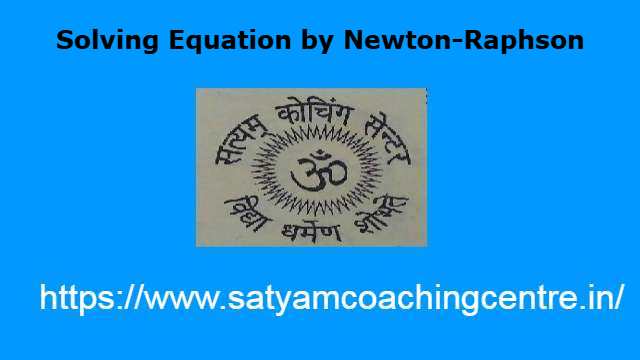Solving Equation by Newton-Raphson
1.न्यूटन-रेफसन विधि से समीकरण हल करना (Solving Equation by Newton-Raphson),न्यूटन-रेफसन विधि का प्रयोग करके समीकरण के मूल ज्ञात करना (Find Root of Equation Using Newton-Raphson Method):
न्यूटन-रेफसन विधि से समीकरण हल करना (Solving Equation by Newton-Raphson) के इस आर्टिकल में बीजीय तथा अबीजीय समीकरणों के मूल न्यूटन-रेफसन विधि से ज्ञात करना सीखेंगे।
आपको यह जानकारी रोचक व ज्ञानवर्धक लगे तो अपने मित्रों के साथ इस गणित के आर्टिकल को शेयर करें।यदि आप इस वेबसाइट पर पहली बार आए हैं तो वेबसाइट को फॉलो करें और ईमेल सब्सक्रिप्शन को भी फॉलो करें।जिससे नए आर्टिकल का नोटिफिकेशन आपको मिल सके।यदि आर्टिकल पसन्द आए तो अपने मित्रों के साथ शेयर और लाईक करें जिससे वे भी लाभ उठाए।आपकी कोई समस्या हो या कोई सुझाव देना चाहते हैं तो कमेंट करके बताएं।इस आर्टिकल को पूरा पढ़ें।
Also Read This Article:- Solve Equations by Newton-Raphson
2.न्यूटन-रेफसन विधि से समीकरण हल करना के उदाहरण (Solving Equation by Newton-Raphson Illustrations):
Illustration:11.न्यूटन-रेफसन विधि से का वास्तविक मूल छ: दशमलव स्थानों तक ज्ञात कीजिए।
(Find the real root of upto six decimal places by Newton-Raphson Method):
Solution:मानलो f(x)=2 x-3 \sin x-5 \\ f^{\prime}(x)=2-3 \cos x
पुनः f(2.75)=2 \times 2.75-3 \sin \left(2.75 \text { रेडियन }\right)-5 \\ =5.5-3 \sin \left(\frac{2.75 \times 180}{3.1428} \text { डिग्री }\right)-5 \\ \approx 0.5-3 \sin \left(157.502864^{\circ}\right) \\ \approx 0.5-3 \times 0.382637 \\ \approx 0.5-1.147911 \\ \Rightarrow f(2.75) \approx -0.647911 \\ f(3)=2 \times 3-3 \sin (3 \text { रेडियन } )-5 \\ =1-3 \sin \left(\frac{3 \times 180}{3.1428} \text{ डिग्री }\right) \\ \approx 1-3 \sin \left(171.821306^{\circ}\right) \\ \approx 1-3 \times 0.142261 \\ \approx 1-0.426783 \\ \Rightarrow f(3) \approx 0.573217
अतः दिए हुए समीकरण का एक मूल 2.75 तथा 3 के मध्य स्थित होगा।
न्यूटन-रेफसन के प्रतिवर्तन सूत्र (recursion formula) सेः
x_{n+1}=x_n-\frac{f\left(x_n\right)}{f^{\prime}\left(x_n\right)} \\ \Rightarrow x_{n+1}=x_n-\frac{\left(2 x_n-3 \sin x_n-5\right)}{2-3 \cos x_n} \\ =\frac{2 x_n-3 x_n \cos x_n-2 x_n+3 \sin x_n+5}{2-3 \cos x_n} \\ \Rightarrow x_{n+1}=\frac{-3 x_n \cos x_n+3 \sin x_n+5}{2-3 \cos x_n} \cdots(1)
अब मूल का प्रारम्भिक मान x_{0}=2.75 लेकर (1) में n=0 रखने पर प्रथम सन्निकटन मान x_{1} होगाः
x_1=\frac{-3 x_0 \cos x_0+3 \sin x_0+5}{2-3 \cos x_0} \\ =\frac{-3 \times 2.75 \cos (2.75 \text { रेडियन })+3 \sin 2.75 \text { रेडियन }+5}{2-3 \cos (2.75 \text { रेडियन }) } \\ = \frac{-8.25 \cos \left(\frac{2.75 \times 180}{3.1428} \text { डिग्री }\right)+ 3 \sin \left(\frac{2.75 \times 180}{3.1428} \text { डिग्री }\right)+5}{2-3 \cos \left(\frac{2.75 \times 180}{3.1428} \text { डिग्री }\right)} \\ \approx \frac{-8.25 \cos \left( 157.502864^{\circ}\right)+3 \sin \left(157.502864^{\circ}\right)+5}{2-3 \cos \left(157.582864^{\circ} \right)} \\ \approx \frac{-8.25 \times-0.923899+3 \times 0.382637+5}{2-3 \times -0.923899} \\ \approx \frac{7.622167+1.147911+5}{2+2.771697} \\ \approx \frac{13.770078}{4.771697} \\ \Rightarrow x_1 \approx 2.885782
पुनः (1) में n=1 रखने पर द्वितीय सन्निकटन मान x_{2} होगाः
x_2= \frac{-3 x_1 \cos x_1+3 \sin x_1+5}{2-3 \cos x_1} \\ =\frac{-3 \times 2.885782 \cos (2.885782 \text { रेडियन })+3 \sin (2.885782 \text { रेडियन })+5}{2-3 \cos (2.885782 \text { रेडियन })} \\ =\frac{-8.657346 \cos \left(\frac{2.885782 \times 180}{3.1428} \text { डिग्री } \right)+3 \sin \left(\frac{2.885782 \times 180}{3.1428} \text { डिग्री }\right)+5}{2-3 \cos \left(\frac{2.885782 \times 180}{3.1428} \text { डिग्री }\right)} \\ \approx \frac{-8.657346 \cos \left(165.279611^{\circ}\right)+3 \sin \left(165.279611^{\circ}\right)+5}{2-3 \cos \left(165.279611^{\circ}\right)} \\ \approx \frac{-8.657346 \times -0.967177+3 \times 0.254102+5}{2-3 \times-0.967177} \\ \approx \frac{8.373186+0.762306+5}{2+2.901531} \\ \approx \frac{14.135492}{4.901531} \\ \Rightarrow x_2 \approx 2.883893
इसी प्रकार (1) में n=2 रखने पर तृतीय सन्निकटन मान x_{3} होगाः
x_3=\frac{-3 x_2 \cos x_2+3 \sin x_2+5}{2-3 \cos x_2} \\ =\frac{-3 \times 2.883893 \cos (2.883893 \text { रेडियन })+3 \sin (2.883893 \text { रेडियन })+5}{2-3 \cos (2.883893 \text { रेडियन })} \\ =\frac{-8.651679 \cos \left(\frac{2.883893 \times 180}{3.1428} \text { डिग्री }\right)+3 \sin \left(\frac{2.883893 \times 180}{3.1428} \text{ डिग्री }\right)+5}{2-3 \cos \left(\frac{2.883893 \times 180}{3.1428} \text{ डिग्री }\right)} \\ \approx \frac{-8.651679 \cos \left(165.171420^{\circ}\right)+3 \sin \left(165.171420^{\circ}\right)+5}{2-3 \cos \left(165.171420^{\circ}\right)} \\ \approx \frac{-8.651679 \times -0.966696+3 \times0.255928+5}{2-3 \times -0.966696 \text { }} \\ \approx \frac{8.363543+0.767784+5}{2+2.900088} \\ \approx \frac{14.131327}{4.900088} \\ \Rightarrow x_3 \approx 2.883892
यहाँ स्पष्ट है कि x_2 \approx x_3 \approx 2.883892 अतः दिए हुए समीकरण का एक मूल 2.883892 होगा।
Illustration:12.न्यूटन-रेफसन विधि द्वारा e^{-x}-\sin x=0 का मूल न्यूनतम मूल चार दशमलव स्थानों तक ज्ञात कीजिए।
(Find to four decimal the smallest root of the equation e^{-x}-\sin x=0 using Newton-Raphson method.)
Solution:मानलो f(x)=e^{-x}-\sin x
तब f^{\prime}(x)=-e^{-x}-\cos x
पुनः f(0.5)=e^{-0.5}-\sin (0.5 \text { रेडियन } ) \\ =0.6065-\sin \left(\frac{0.5 \times 180}{3.1428} \text { डिग्री }\right) \\ \approx 0.6065-\sin \left(28.6369^{\circ}\right) \\ \approx 0.6065-0.4793 \\ \Rightarrow f(0.5) \approx 0.1272 \\ f(0.75)=e^{-0.75} \sin (0.75 \text { रेडियन }) \\ =0.4724-\sin \left(\frac{0.75 \times 180}{3.1428} \text { डिग्री } \right) \\ \approx 0.4724-\sin \left(42.9553^{\circ}\right) \\ \approx 0.4724-0.6814 \\ \Rightarrow f(0.75) \approx-0.209
अतः दिए हुए समीकरण का एक मूल 0.5 तथा 0.75 के मध्य स्थित होगा।
न्यूटन-रेफसन के प्रतिवर्तन सूत्र (recursion formula) सेः
x_{n+1}=x_n-\frac{f\left(x_n\right)}{f^{\prime}\left(x_n\right)} \\ \Rightarrow x_{n+1}=x_n-\frac{\left(e^{-x_n}-\sin x_n\right)}{-e^{-x_n}-\cos x_n} \\ =\frac{-e^{-x_n} x_n-x_n \cos x_n-e^{-x_n}+\sin x_n}{-e^{-x_n}-\cos x_n} \\ \Rightarrow x_{n+1}=\frac{-\left(1+x_n\right) e^{-x_n}-x_n \cos x_n+\sin x_n}{-e^{-x_n}-\cos x_n}\cdots(1)
अब मूल का प्रारम्भिक मान x_{0}=0.5 लेकर (1) में n=0 रखने पर प्रथम सन्निकटन x_{1} मान होगाः
x_1=\frac{-\left(1+x_0\right) e^{-x_0}-x_0 \cos x_0+\sin x_0}{-e^{x_0}-\cos x_0} \\ =\frac{-(1+0.5) e^{-0.5}-0.5 \cos (0.5 \text { रेडियन } )+\sin (0.5 \text { रेडियन })}{-e^{0.5}-\cos (0.5 \text { रेडियन })} \\ =\frac{-1.5 \times 0.6065-0.5 \cos \left(\frac{0.5 \times 180}{3.1428} \text{ डिग्री }\right) +\sin \left(\frac{0.5 \times 180}{3.1428} \text { डिग्री }\right)}{-0.6065-\cos \left(\frac{0.5 \times 180}{3.1428} \text{ डिग्री }\right)} \\ \approx \frac{-0.90975-0.5 \cos \left(28.6369^{\circ}\right) +\sin \left(28.6369^{\circ}\right)}{-0.6065-\cos \left(28.6369^{\circ}\right)} \\ \approx \frac{-0.90975-0.5 \times 0.8777+0.4793}{-0.6065-0.8777} \\ \approx \frac{-0.43045-0.43885}{-1.4842} \\ \approx \frac{0.8693}{1.4842} \\ \Rightarrow x_1 \approx 0.5857
पुनः (1) में n=1 रखने पर द्वितीय सन्निकटन मान x_{2} होगाः
x_2=\frac{-\left(1+x_1\right) e^{-x_1}-x_1 \cos x_1+\sin x_1}{-e^{-x_1}-\cos x_1} \\ =\frac{-(1+0.5857) e^{-0.5857} -0.5857 \cos (0.5857 \text{रेडियन} )+\sin (0.5857 \text { रेडियन } )}{-e^{-0.5857}-\cos (0.5857 \text{ रेडियन } )} \\ =\frac{-1.5857 \times 0.5567-0.5857 \cos \left(\frac{0.5857 \times 180}{3.1428} \text{ डिग्री }\right)+\sin \left(\frac{0.5857 \times 180}{3.1428} \text{ डिग्री }\right)}{-0.5567-\cos \left(\frac{0.5857 \times 180}{3.1428} \text{ डिग्री }\right)}\\ \approx \frac{-0.8828-0.5857 \cos \left(33.5452^{\circ} \right) +\sin \left(33.5452^{\circ}\right)}{-0.5567-\cos \left(33.5452^{\circ}\right)} \\ \approx \frac{-0.8828-0.5857 \times 0.8335+0.5526}{-0.5567-0.8335} \\ \approx \frac{-0.8828-0.4882+0.5526}{-1.3902} \\ \approx \frac{-0.8184}{-1.3902} \\ \Rightarrow x_2 \approx 0.5887
इसी प्रकार (1) में n=2 रखने पर तृतीय सन्निकटन मान x_{3} होगाः
x_3=\frac{-\left(1+x_2\right) e^{-x_2}-x_2 \cos x_2+\sin x_2}{-e^{-x_2}-\cos x_2} \\ =\frac{-(1+0.5887) e^{-0.5887}-0.5887 \cos (0.5887 \text { रेडियन } )+\sin (0.5887 \text{ रेडियन })}{-e^{-0.5887}-\cos (0.5887 \text { रेडियन } )} \\ =\frac{-1.5887 \times 0.555-0.5887 \cos \left(\frac{0.5887 \times 180}{3.1428} \text{डिग्री}\right)+\sin \left(\frac{0.5887 \times 180}{3.1428} \text{ डिग्री }\right)}{-0.555-\cos \left(\frac{0.5887 \times 180}{3.1428} \text{डिग्री}\right)} \\ \approx \frac{-0.8817-0.5887 \cos \left(33.7774^{\circ}\right) +\sin \left(33.7171^{\circ}\right)}{-0.555-\cos (33.7171^{\circ})} \\ \approx \frac{-0.8817-0.5887 \times 0.8318+0.5551}{-0.555-0.8318} \\ \approx \frac{-0.8817-0.4897+0.5551}{-1.3868} \\ \approx \frac{-0.8163}{-1.3868} \\ \Rightarrow x_3 \approx 0.5886
यहाँ स्पष्ट है कि x_2 \approx x_3 \approx 0.5886 अतः दिए हुए समीकरण का एक मूल 0.5886 होगा।
Illustration:14.मिथ्या-स्थिति तथा न्यूटन-रेफसन विधि द्वारा समीकरण 3 x-\cos x-1=0 को हल कीजिए।
(Solve 3 x-\cos x-1=0 by false position method and Newton-Raphson method.)
Solution:मानलो f(x)=3 x-\cos x-1\\ f^{\prime}(x)=3+\sin x
तब f(1.00)=3 \times 1.00-\cos (1.00 \text { रेडियन })-1 \\ =3.00-\cos \left(\frac{1.00 \times 180}{3.1428} \text{डिग्री}\right)-1 \\ \approx 2.00-\cos (57.27376^{\circ}) \\ \Rightarrow f(1.00) \approx 1.45937
पुनः f(0.5) =3 \times 0.5-\cos (0.5 \text{रेडियन})-1 \\ =1.5-\cos \left(\frac{0.5 \times 180}{3.1428} \text{डिग्री}\right)-1 \\ \approx 0.5-\cos \left(28.63688^{\circ}\right) \\ \approx 0.5-0.87767 \\ \Rightarrow f(0.5) \approx-0.37767
अतः दिए हुए समीकरण का एक मूल 0.5 तथा 1 के मध्य स्थित होगा।
मिथ्या-स्थिति विधि का प्रतिवर्तन सूत्र (recursion formula) हैः
x_{n+1}=x_n-\frac{\left(x_n-x_{n-1}\right) f\left(x_n\right)}{f\left(x_n\right)-f\left(x_{n-1}\right)}
जहाँ प्रत्येक चरण के लिए f\left(x_{n-1}\right) f\left(x_n\right)<0 \\ \Rightarrow x_{n+1}=\frac{x_n f\left(x_n\right)-x_n f\left(x_n\right)+x_{n-1} f\left(x_n\right)-x_n f\left(x_{n-1}\right)}{f\left(x_n\right)-f\left(x_{n-1}\right)} \\ \Rightarrow x_{n+1}=\frac{x_{n-1} f\left(x_n\right)-x_n f\left(x_{n-1}\right)}{f\left(x_n\right)-f\left(x_{n-1}\right)} \cdots(1)
प्रथम सन्निकटनः
सूत्र (1) में n=2, x_1=0.5, f\left(x_1\right)=0.37767 , x_2=1, f\left(x_2\right)=1.45937 रखने परः
x_3=\frac{x_1 f\left(x_2\right)-x_2 f\left(x_1\right)}{f\left(x_2\right)-f\left(x_1\right)} \\ \approx \frac{0.5 \times 1.45937+1 \times 0.37767}{1.45937+0.37767} \\ \frac{0.729685+0.37767}{1.83704} \\ \Rightarrow x_3 \approx \frac{1.107355}{1.83704} \\ x_3 \approx 0.60279 \\ f\left(x_3\right)=3 \times 0.60279-\cos (0.60279 \text{रेडियन})-1 \\=1.80837-\cos \left(\frac{0.602759 \times 180}{3.1450} \text{डिग्री} \right)-1 \\ \approx 1.80837-\cos \left(34.52405^{\circ}\right)-1 \\ \approx 0.80837-0.82389 \\ \Rightarrow f\left(x_3\right) \approx -0.01552
अतः मूल अन्तराल [0.60279,1] में स्थित होगा।
द्वितीय सन्निकटनः
पुनः (1) मेंः n=3, x_2=0.60279 ,f\left(x_2\right)=-0.01552, x_3=1 , f\left(x_3\right)=1.45937 रखने परः
अब x_4=\frac{x_2 \cdot f\left(x_3\right)-x_3 \cdot f\left(x_2\right)}{f\left(x_3\right)-f\left(x_2\right)} \\ =\frac{0.60279 \times 1.45937-1 \times-0.01552}{1.45937+0.01552} \\ \approx \frac{0.87969+0.01552}{1.47489} \\ \approx \frac{0.89521}{1.47489} \\ \Rightarrow x_4 \approx 0.60696
अब f(x_4)=3 \times 0.60696-\cos (0.60696 \text { रेडियन })-1 \\=1.82088-\cos \left(\frac{0.60696 \times 180}{3.1428} \text{डिग्री}\right)-1 \\ \approx 0.82088-\cos \left(34.76289^{\circ}\right) \\ \approx 0.824088-0.82152 \\ \Rightarrow f(x_4) \approx-0.00064
अतः मूल अन्तराल [0.60696,1] में स्थित होगा।
तृतीय सन्निकटनः
पुनः (1) में n=4, x_3=0.60696, f\left(x_3\right)=-0.00064 ,x_4=1, f\left(x_4\right)=1.45937 रखने परः
x_5 =\frac{x_3 f\left(x_4\right)-x_4 f\left(x_3\right)}{f\left(x_4\right)-f\left(x_3\right)} \\ =\frac{0.60696 \times 1.45937-1 \times-0.00064}{1.45937+0.00064} \\ \approx \frac{0.88578+0.00064}{1.46001} \\ \approx \frac{0.88642}{1.46001} \\ \Rightarrow x_5 \approx 0.60713
अतः पाँच दशमलव स्थानों तक वास्तविक मूल लगभग 0.60713 होगा।
न्यूटन-रेफसन के प्रतिवर्तन सूत्र (recursion formula) सेः
x_{n+1}=x_n-\frac{f\left(x_n\right)}{f^{\prime}\left(x_n\right)} \\ =x_n-\frac{\left(3 x_n-\cos x_n-1\right)}{3+\sin x_n} \\ =\frac{3 x_n+x_n \sin x_n-3 x_n+\cos x_n+1}{3+\sin x_n} \\ \Rightarrow x_{n+1} =\frac{x_n \sin x_n+\cos x_n+1}{3+\sin x_n} \cdots(2)
अब मूल का प्रारम्भिक सन्निकट मान x_{0}=0.5 लेकर (1) में n=0 रखने पर प्रथम सन्निकटन मान x_{1} होगाः
x_1=\frac{x_0 \sin x_0+\cos x_0+1}{3+\sin x_0} \\ =\frac{0.5 \sin (0.5)+\cos (0.5)+1}{3+\sin (0.5)} \\ =\frac{0.5 \sin \left(\frac{0.5 \times 180}{3.1428} \text { डिग्री }\right)+\cos \left(\frac{0.5 \times 180}{3.1428} \text { डिग्री } \right)+1 }{3+\sin \left(\frac{0.5 \times 180}{3.1428} \text { डिग्री }\right)} \\ =\frac{0.5 \sin \left(28.63688^{\circ}\right)+\cos \left(28.63688^{\circ}\right)+1}{3+\sin \left(28.63688^{\circ}\right)} \\ \approx \frac{0.5 \times 0.47926+0.87767+1}{3+0.47926} \\ \approx \frac{0.23963+0.87767+1}{3.47926} \\
\approx \frac{2.1173}{3.47926} \\ \Rightarrow x_1 \approx 0.60855
पुनः (2) में n=1 रखने पर द्वितीय सन्निकटन मान x_{2} होगाः
x_2=\frac{x_1 \sin x_1+\cos x_1+1}{3+\sin x_1} \\ =\frac{0.60855 \sin (0.60855 \text { रेडियन } )+\cos \left(0.60855 \text{रेडियन} \right)+1}{3+\sin (0.60855 \text { रेडियन })} \\=\frac{0.60855 \sin \left(\frac{0.60855 \times 180}{3.1428} \text { डिग्री } \right)+\cos \left(\frac{0.60855 \times 180}{3.1428} \text{डिग्री}\right)+1}{3+\sin \left(\frac{0.60855 \times 180}{3.1428} \text {डिग्री }\right)} \\ \approx \frac{0.60855 \sin \left(34.85395^{\circ}\right)+\cos \left(34.85395^{\circ}\right)+1}{3+\sin \left(34.85395^{\circ}\right)} \\ \approx \frac{0.60855 \times 0.57149+0.82061+1}{3+0.57149} \\ \approx \frac{0.34778+1.82061}{3.57149} \\ \approx \frac{2.16839}{3.57149} \\ \Rightarrow x_2 \approx 0.60713
इसी प्रकार (2) में n=2 रखने पर तृतीय सन्निकटन मान x_{3} होगाः
x_{3} =\frac{x_2 \sin x_2+\cos x_2+1}{3+\sin x_2} \\ =\frac{0.60713 \sin (0.60713 \text { रेडियन })+\cos (0.60713 \text { रेडियन })+1}{3+\sin (0.60713 \text { रेडियन })} \\ =\frac{0.60713 \sin \left(\frac{0.60713 \times 180}{3.1428} \text { डिग्री }\right)+\cos \left(\frac{0.60713 \times 180}{3.1428} \text { डिग्री }\right)+1}{3+\sin \left(\frac{0.60713 \times 180}{3.1428} \text { डिग्री }\right)} \\ \approx \frac{0.6073 \sin \left(34.77262^{\circ}\right)+\cos \left(34.77262^{\circ}\right)+1}{3+\sin \left(34.77262^{\circ}\right)} \\ \approx \frac{0.60713 \times 0.57032+0.82142+1}{3+\sin 0.57032} \\ \approx \frac{0.34626+1.82142}{3+0.57032} \\ \approx \frac{2.16768}{3.57032} \\ \Rightarrow x_3 \approx 0.60713
यहाँ स्पष्ट है कि x_2 \approx x_3 \approx 0.60713 अतः दिए हुए का एक मूल 0.60713 होगा।
उपर्युक्त उदाहरणों के द्वारा न्यूटन-रेफसन विधि से समीकरण हल करना (Solving Equation by Newton-Raphson),न्यूटन-रेफसन विधि का प्रयोग करके समीकरण के मूल ज्ञात करना (Find Root of Equation Using Newton-Raphson Method) को समझ सकते हैं।
3.न्यूटन-रेफसन विधि से समीकरण हल करना की समस्याएँ (Solving Equation by Newton Raphson Problems):
(1.)न्यूटन-रेफसन विधि द्वारा समीकरण x^3+x^2+3 x+4=0 का न्यूनतम मूल चार दशमलव स्थानों तक ज्ञात कीजिए।
(Find the four places of decimal the smallest root of the equation x^3+x^2+3 x+4=0 using Newton-Raphson method.)
(2.)न्यूटन-रेफसन विधि द्वारा x^3-25=0 को दशमलव के तीन स्थानों तक हल कीजिए।
(Solve x^3-25=0 by Newton-Raphson’s method, correct to three places of decimal.)
उत्तर (Answers):(1.)-1.2225 (2.)2.924
उपर्युक्त सवालों को हल करने पर न्यूटन-रेफसन विधि से समीकरण हल करना (Solving Equation by Newton-Raphson),न्यूटन-रेफसन विधि का प्रयोग करके समीकरण के मूल ज्ञात करना (Find Root of Equation Using Newton-Raphson Method) को ठीक से समझ सकते हैं।
Also Read This Article:- Numerical Solution by Iteration Method
4.न्यूटन-रेफसन विधि से समीकरण हल करना (Frequently Asked Questions Related to Solving Equation by Newton-Raphson),न्यूटन-रेफसन विधि का प्रयोग करके समीकरण के मूल ज्ञात करना (Find Root of Equation Using Newton-Raphson Method) से सम्बन्धित अक्सर पूछे जाने वाले प्रश्न:
प्रश्न:1.बीजीय तथा अबीजीय समीकरणों के मूल ज्ञात करने वाली विधियों के अभिसरण से क्या आशय है? (What Do You Mean by the Convergence of Methods which Determine the Roots of the Algebraic and Transcendental Equations?):
उत्तर:किसी समीकरण के वास्तविक मूल ज्ञात करने से पहले हम दिए हुये समीकरण के मूल का सन्निकट मान ज्ञात करते हैं और तब उत्तरोत्तर सन्निकट से मूल का वाँछित शुद्धता तक मान ज्ञात करते हैं।यदि किसी विधि में हर बार उत्तरोत्तर सन्निकटन से मूल और ज्यादा नजदीक आता जाये तो हम कहते हैं कि विधि अभिसरित (converge) करती है।
प्रश्न:2.समीकरण को हल करने से क्या आशय है (What Do You Mean by Solving Equation?):
उत्तर:x के वे मान जो समीकरण को सन्तुष्ट करते हैं,समीकरण के मूल (root) कहलाते हैं।किसी भी समीकरण को हल करने का अर्थ उसके मूल ज्ञात करना होता है।
प्रश्न:3.ज्यामितीय रूप से समीकरण के हल करने को समझाइए। (Explain the solution of the equation geometrically)
उत्तर:ज्यामितीय रूप में यदि P_n(x) का लेखाचित्र (graph) x-अक्ष को x=a पर काटता है तो x=a समीकरण P_n(x)=0 का मूल होता है।अतः समीकरण P_n(x)=0 का मूल a होता है यदि और केवल यदि P_n(a)=0 हो।
उपर्युक्त प्रश्नों के उत्तर द्वारा न्यूटन-रेफसन विधि से समीकरण हल करना (Solving Equation by Newton-Raphson),न्यूटन-रेफसन विधि का प्रयोग करके समीकरण के मूल ज्ञात करना (Find Root of Equation Using Newton-Raphson Method) के बारे में और अधिक जानकारी प्राप्त कर सकते हैं।
| No. | Social Media | Url |
|---|---|---|
| 1. | click here | |
| 2. | you tube | click here |
| 3. | click here | |
| 4. | click here | |
| 5. | Facebook Page | click here |
| 6. | click here |
Solving Equation by Newton-Raphson
न्यूटन-रेफसन विधि से समीकरण हल करना
(Solving Equation by Newton-Raphson)
Solving Equation by Newton-Raphson
न्यूटन-रेफसन विधि से समीकरण हल करना (Solving Equation by Newton-Raphson)
के इस आर्टिकल में बीजीय तथा अबीजीय समीकरणों के मूल न्यूटन-रेफसन विधि
से ज्ञात करना सीखेंगे।
Related Posts
About Author
Satyam
About my self I am owner of Mathematics Satyam website.I am satya narain kumawat from manoharpur district-jaipur (Rajasthan) India pin code-303104.My qualification -B.SC. B.ed. I have read about m.sc. books,psychology,philosophy,spiritual, vedic,religious,yoga,health and different many knowledgeable books.I have about 15 years teaching experience upto M.sc. ,M.com.,English and science.








